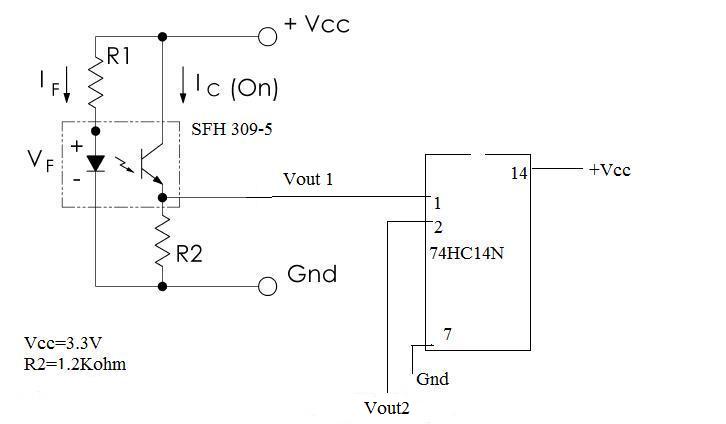PhotoTransistor Question
Hi forum ,
I would like to ask you·about the circuit in the attachment , I am using a phototransistor SFH 309-5 and a 74HC14N to measure the speed of a motor·, i measure on Vout2 their is no voltage·, what do you recommend me ? is this a problem of the choise of R2?
Have a nice day,
Anita
I would like to ask you·about the circuit in the attachment , I am using a phototransistor SFH 309-5 and a 74HC14N to measure the speed of a motor·, i measure on Vout2 their is no voltage·, what do you recommend me ? is this a problem of the choise of R2?
Have a nice day,
Anita



Comments
·
-Phil
Post Edited (PJ Allen) : 10/12/2009 12:16:44 AM GMT
-Phil
WEll, anyway, the last thing I want is for this thread to go side-ways with a dozen Replies about thus and sundry and nothing from the OP.
Good luck.
are you trying to convert a pulse frequency (generated by a photo-interruptor) into a DC voltage?
thank you all , almost all of you speaking about appropriate value of R1 and R2 , what they should be the value if i have the emitter is 3V, 45mA.
thank you in advance
Your 3V emitter voltage sounds as if you're using a white LED. Is there any particualr reason for this? The detector sensitivity peaks in the red to near IR, so a red LED would work just as well.
The reason I bring this up is that with a 3.3V supply, a 3V LED doesn't leave you with much headroom for a current-limiting resistor. So it's hard to recommend a value for R1 under these conditions, since the forward voltages within a batch of LEDs can vary so much. A red LED with, typically, a much lower forward voltage would be easier to regulate.
As to the value of R2, it will have to be determined by experimentation. So much depends on how much light reaches the sensor during the "on" and "off" conditions. Can you tell us a little more about your physical setup? For example, are you looking through a slotted disk or at reflected light?
-Phil
Thanks
To get 45mA through the laser diode with a 3.3V source and a diode forward voltage of 3V you would need a resistor value of (3.3 - 3.0) / 0.045 = 6.666 ohms. The closest standard resistor value would be 6.8 ohms for a current of 44.1mA. If you need to get closer to 45mA you could put a 330 ohm resistor in parallel with the 6.8 ohm one.
▔▔▔▔▔▔▔▔▔▔▔▔▔▔▔▔▔▔▔▔▔▔▔▔
C-Bob
Every problem·have at least one·nice, simply and·wrong solution.
-Phil